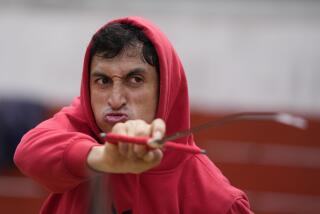Ancient and Bloody Bolivian Ritual Draws a Crowd
- Share via
MACHA, Bolivia -- A bus loaded with tourists pulls into this desolate pueblo on Bolivia’s high plains to watch 6,000 men get drunk and beat themselves to a pulp in a three-day festival known as Tinku.
Tinku, an ancestral ritual that predates the Spanish conquest, consists of rival villages engaging in sometimes deadly hand-to-hand combat that tradition says will secure richer, more prosperous crops in the coming year.
“If a person dies it is better for the fields,” says Rafael Gongora, a nurse at a clinic where a heap of soiled gauze pads will soon overwhelm the waste basket. “If there are no deaths, the custom suffers.”
Death, violence and occasional cannibalism have been central to Tinku for 700 years. But as Tinku’s fame has risen among tourists, so has the government’s concern over international opinion. In recent years, it has cracked down on the violence, threatening the extinction of Bolivia’s strangest Andean festival.
“A friend asked me if I wanted to watch two villages beat ... one another and I said yes,” says Beth Pullan, 24, a Briton among the 30 visitors lured by the ritual battle.
Tinku takes place in early May, when the men of rival villages gather to settle feuds, often over stolen sheep and llama. Macha, a town of 600 that is 19 hours by bus from the capital, La Paz, hosts the largest and what’s believed to be the most authentic Tinku.
Thousands of people from rival villages, dressed in native war garb, meet in the central square at midnight after trekking days over barren mountain desert.
By dawn, the plaza is packed with brightly dressed Indians dancing, whipping each other with braided leather and drinking 96% grain alcohol from plastic jugs.
Dancing soon turns to violence and fighting erupts like liquid in a blender.
Dust rises from a thousand scuttling feet as hundreds of fists thud against cheekbones. Bloodied faces puff beneath the Andean sun. An Indian woman with a baby sleeping in cloths slung over her back drags her tattered husband from the scrum.
Tourists gather along the margins to snap photos, drawing scorn from a drunken elder: “Our culture you take away! We don’t want you here! Go home!”
The visitors stare silently, and migrate to the balcony of the mayor’s residence to watch the mayhem from a safer distance. Disbelief creeps into their faces.
“This is barbarous and I don’t know if it’s a good or bad thing,” says Justin Hall, a cartoonist from San Francisco.
An Indian woman screams and struggles to save her husband from six men kicking his head.
The odor of grain alcohol is heavy in the air.
“It’s like watching a car accident. Now it’s all pure emotion,” says Jerry Tal from Israel. “I don’t know if I should be watching this.”
A police officer appears. A warning shot cracks. Tear gas billows. The fighters scatter, leaving the plaza empty save for one woman choking on the gas and men sprawled unconscious from alcohol and beatings.
The bewildered tourists scurry into the mayor’s office, where explanations are offered by a guide.
“Tinku is violent, but above all peaceful. It is a friendly meeting to test one’s energy. It is like man and woman, above and below, light and shadow,” says Tito Burgoa, a former miner who would like to see Tinku become a controlled tourist event. “When they are done fighting, they say: ‘Thank you brother; we have tested one another.’ ”
Young men and old alike fight to test their valor and sometimes to secure a bride.
“It is done to improve our culture. Let them see Bolivian peasant culture!” roars Renato Teculkano, a young fighter with dried blood on his face. “It is beautiful and full of emotion.”
The combatants see the violence as a means of keeping the peace among neighboring villages, concentrating a year of anger and slights into a single clash.
“We fight today, and hug tomorrow,” says Juan Capichiri, 27. “We fight clean, man to man, fist to fist, face to face. We fight as brothers.”
Few tourists see any beauty in the bloodletting.
“I came determined not to judge this on my Western values,” says Alex Kent from England. “But this is sick. Women and children crying; this is sick.”
A stream of bloody and broken bodies limp to the clinic and wince as Dr. Ilda Martinez sutures split lips for 30 cents a stitch. “Booze is their anesthesia,” she says.
She has seen no one die, but is sure deaths will occur at some Tinku.
Newspaper reports said two people died this year in Macha, despite six police officers patrolling with whips, billy clubs and tear gas.
Worried about international reaction to the bloodletting, the government outlawed the use of traditional helmets six years ago in hopes of discouraging more men from fighting. The ban resulted only in more head injuries.
Three years ago, authorities paved over Macha’s plaza to keep fighters from using cobblestones as weapons, but rocks still fly.
Most people in Macha, which got electricity just two years ago and has but one telephone, believe Tinku eventually will be stamped out.
“Before there was more fighting, but now it is changing,” says Fausto Romero. “The laws of the state prevent us from expressing ourselves.”
More to Read
Sign up for The Wild
We’ll help you find the best places to hike, bike and run, as well as the perfect silent spots for meditation and yoga.
You may occasionally receive promotional content from the Los Angeles Times.






